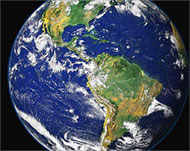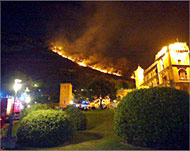Europe’s summer of death
Europe’s deadly summer heatwave has ignited a fierce continent-wide debate: Was this a one-off tragedy, or the result of complacency about global warming?

More than 20,000 people are believed to have died accross Europe in this summer’s heatwave.
At least 10,000 victims, many of them elderly, perished in France in temperatures of more than 40C (104F).
As a result, a political row has been raging in France over who was to blame, with some critics blaming the government for responding too slowly. The French newspaper Le Figaro recently reported that 300-400 bodies were lying unclaimed in Paris alone.
Earlier, Surgeon General Lucien Abenhaim resigned on 18 August after an admission by the French health minister, Jean-Francois Mattei, that an estimated 5000 weather-related deaths was “a plausible figure”.
Elsewhere, countries such as Italy have been so overwhelmed with casualties that they have struggled to produce figures.
Weather warning
Yet, UN scientists predicted these extreme weather conditions just a couple of months ago: the foreseeable result, they say, of global warming.
The World Meteorological Organisation (WMO) – a UN specialist agency based in Geneva, Switzerland – released a statement on 2 July called Extreme Weather Events Might Increase.
National governments showed little interest.
 |
|
Global warming has been linked |
Dr Buruhani Nyenzi, the WMO’s Chief of World Climate Applications and a participant in the World Climate Programme (WCP), agrees this summer’s heatwave fits a predicted picture of rising global temperatures.
“We believe recent extreme weather conditions in Europe and elsewhere are fully consistent with the changes in extreme conditions noted in recent years,” he says.
Fatal weather
Global warming may already have caused dangerous and fatal weather occurrences. The WMO’s July warning highlighted record temperatures and freak weather events that had occurred in the first half of 2003.
For example, May witnessed “a record for the number of tornadoes” in the United States – 562 that month. The previous record was 399 in July 1992. At the same time, the southern United States was recording temperatures between 2C and 6C below average.
Meanwhile, in India, the report said around 1500 people had died because of a monsoon season whose temperatures were 5C above average. In Sri Lanka, the monsoons killed 300 people and reduced the staple tea crop by 30% – severely damaging the local economy.
As Dr Nyenzi points out, it is still unclear how governments reacted to the WMO’s warning.
“The recently issued WMO press release on extreme weather events attracted the attention of many national and international news media … [but] it is not yet known what measures were taken by governments.”
Government inaction
Not many effective ones, it seems. Across Europe, people have been dying in their thousands, especially the elderly.
Pressed by the media, Parisian hospitals issued mortality statistics for the first time this summer. They estimated “at least 50 deaths” in one weekend, 9-10 August.
But this may only the tip of the iceberg. One hospital, St Andre in Bordeaux, reported 20 deaths on the same weekend due to the heatwave. There were many reported deaths in Nancy and Toulouse. In Lyon, hospitals were so overwhelmed by heat-related cases they could not offer accurate figures.
 |
|
A Lyon undertaker handles the |
On 13 August, a new record was set: temperatures in France did not drop below 25.2C anywhere in the country, even at night.
In the south of the country, Perpignan became the first city to issue warnings to its citizens about levels of ozone, which reached 180 micrograms per cubic metre of air.
Ozone is a gas that normally found high in the Earth’s atmosphere. Created by pollution combined with heat, it becomes trapped in large clouds at a low level. At such altitudes, it is harmful to humans – especially those with respiratory illnesses.
European weather forecasters have called these large drifting clouds of ozone the Barcelona effect. The clouds have been moving slowly along the coasts of Spain and France, between major cities such as Barcelona and Marseille, and affecting areas previously thought safe.
Fires
As well as deaths from heat exhaustion, pollution and dehydration, people are also dying in the rash of forest fires across the continent.
In France, tourists have died after becoming trapped in vehicles, campsites have been destroyed and firefighters have been killed. Hundreds of thousands of acres of farmland and hundreds of homes have been destroyed across the south.
Blazes in north-east Spain killed seven people, including one firefighter, in less than a week.
Hardest hit by the forest fires, Portugal declared a national emergency, losing at least 18 people to the blazes. More than 250,000 hectares of forest have been devasted.
Projected global warming
Lack of conclusive proof means most scientists do not claim a single individual death, fire or drought in Europe has been a direct result of global warming.
 |
|
A blaze the mountains of Alvano |
But Nyenzi is adamant the evidence strongly suggests global warming – caused by humans – is to blame.
“What is now being experienced is compatible with our understanding of climate change as a result of observed and projected global warming -principally as a result of human activity,” he says.
So, did climate change cause Europe’s summer of death – and can we expect more extreme weather across the planet?
“The simple and clear answer is ‘yes’. If our understanding of current and future global warming and consequent climate change is correct, then we expect extreme events to be experienced more frequently in the future.”